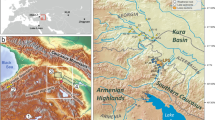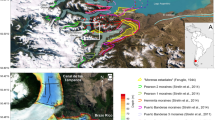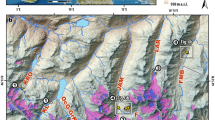Abstract
The Waiho Loop moraine on South Island, New Zealand, has been interpreted as a consequence of Younger Dryas cooling in New Zealand1, and thus as evidence for inter-hemisphere synchroneity of climate change2,3. However, recent work has challenged both the timing of the event4 and whether strong cooling was necessary to initiate the advance4,5. Here, we characterize the sedimentology of the moraine to assess the possible causes of the advance. Our analysis shows that the composition of the Waiho Loop moraine is different from other moraines in the region, with respect to both the composition and the type of clasts present. We deduce that the moraine represents the end product of a major landslide onto the Franz Josef glacier, which triggered a substantial glacial advance. In combination with the revised age4 and temperature6,7 estimates for this region, our results suggest that there was no significant climatic forcing of this advance, including an alternative precipitation-driven model. Our study shows that glacial moraines are not necessarily climatic in origin, which must be taken into account when evaluating the mass balance responses of glacial systems1,8.
This is a preview of subscription content, access via your institution
Access options
Subscribe to this journal
Receive 12 print issues and online access
$259.00 per year
only $21.58 per issue
Buy this article
- Purchase on Springer Link
- Instant access to full article PDF
Prices may be subject to local taxes which are calculated during checkout


Similar content being viewed by others
References
Anderson, B. & Mackintosh, A. Temperature change is the major driver of late-glacial and Holocene fluctuations in New Zealand. Geology 34, 121–124 (2006).
Broecker, W. S. Abrupt climate change: Causal constraints provided by the paleoclimate record. Earth Sci. Rev. 51, 137–154 (2000).
Denton, G. H. & Hendy, C. H. Younger Dryas age advance of Franz Josef Glacier in the Southern Alps of New Zealand. Science 264, 1434–1437 (1994).
Barrows, T. T., Lehman, S. J., Fifield, L. K. & DeDeckker, P. Absence of cooling in New Zealand and the adjacent ocean during the Younger Dryas Chronozone. Science 318, 86–89 (2007).
Shulmeister, J., Fink, D. & Augustinus, P. C. A cosmogenic nuclide chronology of the last glacial transition in North–West Nelson, New Zealand—new insights in Southern Hemisphere climate forcing during the last deglaciation. Earth Planet. Sci. Lett. 233, 455–466 (2005).
Singer, C., Shulmeister, J. & McLea, W. Evidence against a significant Younger Dryas cooling event in New Zealand. Science 281, 812–814 (1998).
Robinson, L. F., Henderson, G. M., Hall, L. & Matthews, I. Climatic control of riverine and seawater Uranium-isotope ratios. Science 305, 851–854 (2004).
Oerlemans, J. & Fortuin, J. P. F. Sensitivity of glaciers and small ice caps to greenhouse warming. Science 258, 115–117 (1992).
Burrows, C. J. A chronology for cool-climate episodes in the Southern Hemisphere 12000–1000 Yr. BP. Palaeogeogr. Palaeoclimatol. Palaeoecol. 27, 287–347 (1979).
Mercer, J. H. The age of the Waiho Loop terminal moraine, Franz Josef Glacier, Westland. New Zealand J. Geol. Geophys. 31, 95–99 (1988).
Ivy-Ochs, S., Schlüchter, C., Kubik, P. W. & Denton, G. H. Moraine exposure dates imply synchronous Younger Dryas glacier advances in European Alps and in the Southern Alps of New Zealand. Geografiska Annaler 81A, 313–323 (1999).
Broecker, W. S. Will our ride into the Greenhouse Future be a smooth one? GSA 5/97.
Mabin, M. C. G. Age of the Waiho Loop glacial event: Comment. Science 271, 868 (1995).
Turney, C. S. M. et al. Redating the advance of the New Zealand Franz Josef Glacier during the last termination: Evidence for asynchronous climate change. Quat. Sci. Rev. 26, 25–28 (2007).
Warren, G. Sheet 17 Hokitika, Geological Map of New Zealand (1:250 000 DSIR, Wellington, 1967).
Grapes, R. & Watanabe, T. Metamorphism and uplift of Alpine schist in the Franz Josef—Fox Glacier area of the Southern Alps, New Zealand. J. Metamorphic Geol. 10, 171–180 (1992).
Kamp, P. J. J. & Tippett, J. M. Dynamics of the Pacific plate crust in the South Island (New Zealand) zone of oblique continent-continent convergence. J. Geophys. Res. 98, 16105–16118 (1993).
Benn, D. I. & Evans, D. J. A. Glaciers and Glaciation (Arnold, London, 1998.).
Hewitt, K. Catastrophic landslide deposits in the Karakoram Himalaya. Science 242, 64–67 (1988).
Nakawo, M. & Rana, B. Estimate of ablation rate of glacier ice under a supraglacial debris layer. Geografiska Annaler 81A, 695–701 (1999).
Hewitt, K. Quaternary moraines versus catastrophic rock avalanches in the Karakoram Himalaya, Northern Pakistan. Quat. Res. 51, 220–237 (1995).
Orwin, J. The application and implications of rock weathering rind dating to a large rock avalanche, Craigieburn Range, Canterbury, New Zealand. New Zealand J. Geol. Geophys. 41, 219–223 (1998).
Hancox, G. T. & Perrin, N. D. Green Lake Landslide: A very large ancient rock slide in Fiordland, New Zealand. Science Report 93/18, (Institute of Geological and Nuclear Sciences, Lower Hutt, New Zealand, 1994).
Wells, A., Yetton, M. D., Duncan, R. P. & Stewart, G. H. Prehistoric dates of the most recent Alpine Fault earthquakes, New Zealand. Geology 27, 995–998 (1999).
Rhoades, D. A. & Van Dissen, R. J. Estimates of the time-varying hazard of rupture of the Alpine Fault, New Zealand, allowing for uncertainties. New Zealand J. Geol. Geophys. 46, 479–488 (2003).
Carter, L., Manighetti, B. & Neil, H. From icebergs to pongas: Antarctica’s ocean link with New Zealand. Water Atmosphere online 11, 30–31 (2003).
Turney, C. S. M., McGlone, M. S. & Wilmshurst, J. M. Asynchronous climate change between New Zealand and the North Atlantic during the last deglaciation. Geology 31, 223–226 (2003).
Laird, M. G. Sedimentology of the Greenland Group in the Paparoa Range, West Coast, South Island. New Zealand J. Geol. Geophys. 15, 372–393 (1970).
Acknowledgements
This work was supported by a Mason Trust grant to D.S.T. and an internal University of Canterbury, Geological Sciences Department grant to J.S. and T.R.D.
Author information
Authors and Affiliations
Contributions
D.S.T. undertook the fieldwork, data analyses and drafted the figures. J.S. and T.R.D. co-supervised D.S.T., provided project design and co-wrote the paper.
Corresponding author
Supplementary information
Supplementary Information
Supplementary tables S1-S4 and supplementary figures S1-S4 (PDF 728 kb)
Rights and permissions
About this article
Cite this article
Santamaria Tovar, D., Shulmeister, J. & Davies, T. Evidence for a landslide origin of New Zealand’s Waiho Loop moraine. Nature Geosci 1, 524–526 (2008). https://doi.org/10.1038/ngeo249
Received:
Accepted:
Published:
Issue Date:
DOI: https://doi.org/10.1038/ngeo249
This article is cited by
-
Rapid sequestration of rock avalanche deposits within glaciers
Nature Communications (2015)
-
The prehistoric Mt Wilberg rock avalanche, Westland, New Zealand
Landslides (2009)
-
Avalanches and moraines
Nature Geoscience (2008)



